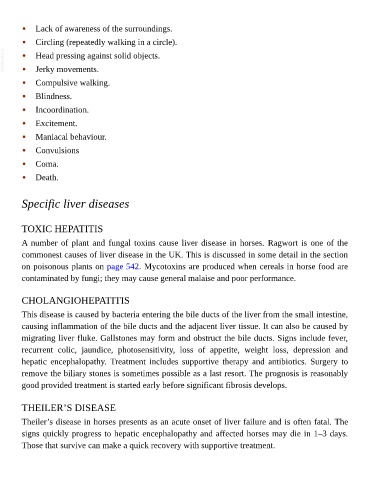Page 788 - The Veterinary Care of the Horse
P. 788
• Lack of awareness of the surroundings.
• Circling (repeatedly walking in a circle).
VetBooks.ir • Head pressing against solid objects.
•
Jerky movements.
• Compulsive walking.
• Blindness.
• Incoordination.
• Excitement.
• Maniacal behaviour.
• Convulsions
• Coma.
• Death.
Specific liver diseases
TOXIC HEPATITIS
A number of plant and fungal toxins cause liver disease in horses. Ragwort is one of the
commonest causes of liver disease in the UK. This is discussed in some detail in the section
on poisonous plants on page 542. Mycotoxins are produced when cereals in horse food are
contaminated by fungi; they may cause general malaise and poor performance.
CHOLANGIOHEPATITIS
This disease is caused by bacteria entering the bile ducts of the liver from the small intestine,
causing inflammation of the bile ducts and the adjacent liver tissue. It can also be caused by
migrating liver fluke. Gallstones may form and obstruct the bile ducts. Signs include fever,
recurrent colic, jaundice, photosensitivity, loss of appetite, weight loss, depression and
hepatic encephalopathy. Treatment includes supportive therapy and antibiotics. Surgery to
remove the biliary stones is sometimes possible as a last resort. The prognosis is reasonably
good provided treatment is started early before significant fibrosis develops.
THEILER’S DISEASE
Theiler’s disease in horses presents as an acute onset of liver failure and is often fatal. The
signs quickly progress to hepatic encephalopathy and affected horses may die in 1–3 days.
Those that survive can make a quick recovery with supportive treatment.

